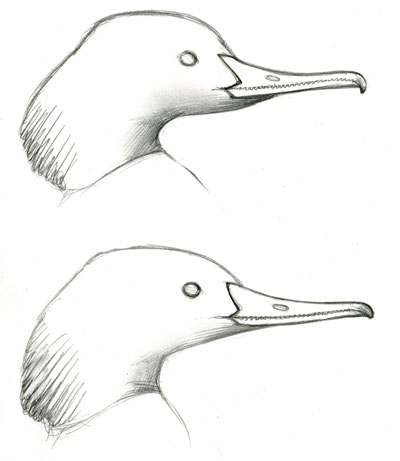The Eurasian subspecies group of Common Merganser, known by the English name Goosander, has occurred numerous times in the Aleutian Islands of western Alaska, but has never been identified farther east in North America. The American subspecies has some potential to wander to Eurasia, but has never been recorded there. I’ve never seen any in-depth discussion of the identification of these subspecies, so I checked some specimens at MCZ ((Museum of Comparative Zoology, Harvard University)) to see if I could find reliable field identification criteria.

Subspecies
M. m. merganser – nests and winters from Iceland to Siberia, recorded rarely but regularly in Aleutian Islands but nowhere else in North America.
M. m. americana – found in North America, never recorded in Iceland or Eurasia.
Another subspecies is found in central Asia.
Male Eurasian vs American
- narrower dark bases of greater coverts hidden by overlapping white median coverts (vs broader black bases with about 5-10 mm of black bar exposed)
This creates a short black bar across the white expanse of flanks and folded wing on American. Eurasian has black bases on the same feathers, but the black is less extensive and is just barely concealed by the overlapping white median coverts. Caution is required, since with a slight change in feather length or position a Eurasian merganser could show black there, and the arrangement of flank feathers and coverts often conceals most or all of the black bar on American birds.
- slightly paler gray on rump. This should be visible in the field in direct comparison
- bill averages stronger hook at tip but both subspecies are variable and there is complete overlap
- feathering at base of bill projects farther forward, creating smaller angle at forehead lobe, angle formed by frontal lobe definitely less than 45 degrees (vs angle about 45 degrees or more)
- culmen curves distinctly up at base, so bill is a little thinner through middle and expands dramatically at base (vs more evenly tapered, relatively straight or gently cirved up to forehead)
- underwing coverts more extensively white, with white reaching leading edge at hand (vs more gray smudges along leading edge)
- head shape more irregular, with small flat crown, indentation at back of head, bulging crest and bulging chin (vs smoother rounded contours and more “normal” sleek head shape)
This is evident across a large series of photos, but there is also variation depending on how the feathers are held. Eurasian birds can compress the feathers to a sleeker outline, and American birds can fluff the feathers to show at least a suggestion of the Eurasian shape. More study is needed to determine how reliable these differences are.
Specimens show no clear difference in length of crest. Pyle 2008, reported that the crest is broader in Eurasian, vs. limited to a narrower ridge down the nape in American, and I did not check this specifically.
It has been reported that American birds show a stronger pinkish-orange wash on the belly, from earlier in winter, than Eurasian birds. This is variable in American birds and any differences are probably merely tendencies and too variable to be used for identification.
Bill may be darker red in Eurasian (reported in Pyle 2008) but I did not check this.
Female Eurasian vs American
- differences in feathering at bill base match males but somewhat less obvious
- paler gray above, and may be less prominently scaly (vs darker gray-brown, with dark feather centers and pale gray edges on mantle creating obviously scaly pattern)
- more extensive white on leading edge of underwing
possibly shorter crest? Some may have drabber brown head color and paler and less richly-colored crest, but there seems to be extensive variation and possibly complete overlap in head color
I found no difference in wing pattern of females, and no consistent difference in face pattern.
Conclusion
Males should be identifiable based on a combination of bill shape, head shape, wing pattern, and perhaps back color, but differences are small, subtle, and possibly overlapping. Still, my sense is that this is enough that an observer who is aware of the differences should notice a bird of the “wrong” subspecies out of range, especially if it is with other mergansers for direct comparison. Females will be much more difficult, but are potentially identifiable by bill shape and back color.
References
Pyle, P. 2008. Identification Guide to North American Birds. Part II. Slate Creek Press.


Dear David,
There was an article on this subject in a European journal that I cannot recall, but I remember clearly seeing a color illustration of males of the two forms, showing the same (or close-to) features you describe above. Sorry for the vagueness, but you might be able to track it down.
Also, the recent (2010) book “Advanced Bird ID Guide; Western Palearctic” by Nils Van Duivenduk there is a section on American Common Merganser, comparing it to Goosander:- the features are basically a subset of the ones you discuss above except that in regard to the dark great covert bar, it says that this can be present on some 2W Goosanders – ?
All the best,
Martin